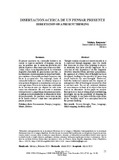Mostrar el registro sencillo del ítem
Disertación acerca de un pensar presente
| dc.rights.license | http://creativecommons.org/licenses/by-nc-sa/3.0/ve/ | es_VE |
| dc.contributor.author | Valdivia, Benjamín | |
| dc.date.accessioned | 2023-12-07T14:55:01Z | |
| dc.date.available | 2023-12-07T14:55:01Z | |
| dc.date.issued | 2023-12-07 | |
| dc.identifier.issn | 0798-1570 | |
| dc.identifier.uri | http://www.saber.ula.ve/handle/123456789/50048 | |
| dc.description.abstract | El pensar mantiene un contenido histórico en cuanto se expresa mediante el lenguaje, puesto que las palabras que lo enuncian provienen del señalar objetos o situaciones que ya han sucedido. Como crítica a esa dependencia de la estructura lingüística heredada de generaciones previas, se ha elaborado el planteamiento de un pensar futuro, que conduzca a lo posible mediante la proyección hacia lo no pensado. Sin embargo, tanto el contenido histórico como el esfuerzo utópico o anticipatorio del pensar se orientan hacia lo que no está aquí ahora. El acto de la duración continuada de la conciencia ante sus objetos ha sido visto como una alternativa. En este texto se analizan estos procesos y, como forma del pensar presente, se indaga en la posibilidad de la detención del fluir del pensamiento. Se concluye con la enunciación de la “mente estética” como base conceptual del pensar presente. Recibido: Abril-2023 / Aceptado: Abril-2023 | es_VE |
| dc.language.iso | es | es_VE |
| dc.publisher | SaberULA | es_VE |
| dc.rights | info:eu-repo/semantics/openAccess | es_VE |
| dc.subject | Pensamiento | es_VE |
| dc.subject | Tiempo | es_VE |
| dc.subject | Lenguaje | es_VE |
| dc.subject | Mente | es_VE |
| dc.subject | Estética | es_VE |
| dc.title | Disertación acerca de un pensar presente | es_VE |
| dc.title.alternative | Dissertation On a present thinking | es_VE |
| dc.type | info:eu-repo/semantics/article | es_VE |
| dc.description.abstract1 | Thought sustains a historical content insofar as it is expressed through language, since the words that enunciate it come from pointing to objects or situations that have already happened. As a criticism of this dependency on the linguistic structure inherited from previous generations, the approach of a future way of thought has been developed, leading to the possible by projecting itself towards the non-thought. However, both the historical content and the utopian or anticipatory eff ort of thinking are oriented by what is not here now. The act of continued duration of consciousness in front of its objects has been seen as an alternative. In this paper we analyze these processes and, as a form of present thinking, investigate too on the possibility of stopping the fl ow of thought. It concludes with the enunciation of the “aesthetic mind” as a conceptual basis for the present thinking. | es_VE |
| dc.description.colacion | 21-30 | es_VE |
| dc.description.email | cifranueva@ula.ve | es_VE |
| dc.description.email | valdivia@ugto.mx | es_VE |
| dc.description.frecuencia | Semestral | |
| dc.description.paginaweb | http://www.saber.ula.ve/cifranueva | |
| dc.identifier.depositolegal | P P92-0047 | |
| dc.identifier.edepositolegal | ppi 201202ME4019 | |
| dc.identifier.eissn | 2244-8438 | |
| dc.publisher.pais | Venezuela | es_VE |
| dc.subject.institucion | Universidad de Los Andes | es_VE |
| dc.subject.keywords | Present thought | es_VE |
| dc.subject.keywords | Time | es_VE |
| dc.subject.keywords | Language | es_VE |
| dc.subject.keywords | Mind stopping | es_VE |
| dc.subject.keywords | Aesthetic mind | es_VE |
| dc.subject.seccion | Revista Cifra Nueva: Artículos | es_VE |
| dc.subject.tipo | Artículos | es_VE |
| dc.type.media | Texto | es_VE |
| dc.contributor.orcid | https://ORCID.org/0000-0002-6444-1476 |
Ficheros en el ítem
Este ítem aparece en la(s) siguiente(s) colección(ones)
-
Cifra Nueva - Nº 048
Julio-Diciembre 2023


